Jesse Ditty’s Recollections of Lovejoy Station
Posted By Norman Gasbarro on January 16, 2019
The National Tribune, 8 June 1899, posted a letter to the editor from Jesse Ditty, a Civil War veteran who is buried at Oak Hill Cemetery, Millersburg, Dauphin County, Pennsylvania. The National Tribune, published at Washington, D.C., was the official newspaper of the Grand Army of the Republic (G.A.R.).
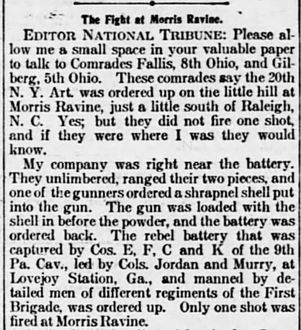
The Fight at Morris Ravine
EDITOR NATIONAL TRIBUNE: Please allow me a small space in your valuable paper to talk to Comrades Fallis, 8th Ohio and Gilberg, 5th Ohio. These comrades say the 20th New York Artillery was ordered up on the little hill at Morris Ravine, just a little south of Raleigh, North Carolina. My company was right near the battery. They unlimbered, ranged their two pieces, and one of the gunners ordered a shrapnel shell put into the gun. The gun was loaded with the shell in before the powder, and the battery was ordered back. The rebel battery that was captured by Companies E, F, C, and K, of the 9th Pennsylvania Cavalry, led by Colonels Jordan and Murry, at Lovejoy Station , Georgia, and manned by detailed men of different regiments, was ordered up. Only one shot was fired at Morris Ravine.
As for line after line of batteries, I can prove to you by Gen. Joe Wheeler himself that there was only one barricade across the road, and extending in the woods about 10 feet on each side. Hampton, Wheeler, or Butler will see me out on that line.
As for a line of battle being formed at the depot, that is not correct. There was a train of box cars at the depot, loaded with Union soldiers. They were prisoners the Johnnnies had and were trying to get out of the way, and they could get no farther. Aaron Dreiger, of the the 46th Pennsylvania Infantry was one of them. He now lives at Mt. Carmel, Pennsylvania.
JESSE B. DITTY, Company E, 9th Pennsylvania Cavalry, Sunbury, Pennsylvania.
While Jesse Ditty‘s letter was primarily concerned with what happened at Morris Ravine, a friendly rebuttal was forthcoming from another veteran who disputed his claim about the rebel battery at Lovejoy Station, Georgia:
Per the National Tribune, 27 July 1899:
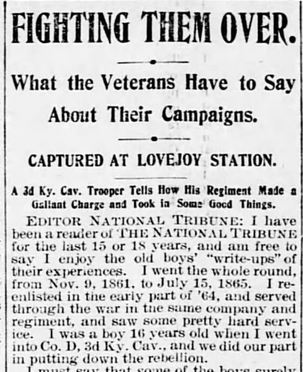
FIGHTING THEM OVER
What the Veterans Have to Say About Their Campaigns.
CAPTURED AT LOVEJOY STATION
A 3rd Kentucky Cavalry Trooper Tells How His Regiment Made a Gallant Charge and Took In Some Good Things.
EDITOR NATIONAL TRIBUNE: I have been a reader of the NATIONAL TRIBUNE for the last 15 or 18 years, and I am free to say I enjoy the old boys write-ups of their experiences. I went the whole round from November 8, 1961 to July 15, 1865. I enlisted in the early part of ’64 and served through the war in the same company and regiment and saw some pretty hard service. I was a boy 16 years old when I went into Company D, 3rd Kentucky Cavalry, and we did our part in putting down the rebellion.
I must say that some of the boys surely write from hearsay, as I saw Comrade Jesse B. Ditty, Company E, 9th Pennsylvania Cavalry. The comrade surely did not witness that affair as I did, or he would know more about it. Colonels Gordon and Murray were neither present when the charge was made, as the order was given by Kilpatrick in person to Lieutenant-Colonel King, in command of the 3rd Kentucky Cavalry, who ordered and led the charge, and captured the guns and 61 prisoners. If any other part of the command made any charge it was at some different point – not where the two guns were captured, for I was there and heard the order given and the exact words used by Kilpatrick.
We were grazing along in the morning near the head of the column, and some skirmishers in front of us were firing pretty sharply. The rebels had the two cannon on a rise west of the railroad, just north of the station. They had fired several shots that came rattling through the brush, some of them uncomfortably near us. My regiment formed on the left or east side of the road, which ran parallel with the railroad, and were not more than 600 or 700 yards from the guns. We halted in the open woods and Kilpatrick rode down the line from the west, and just as he was passing King, two shots were fired from the rebel guns, and both shots struck in the trees just over our heads, creating some excitement among the horses as well as the men. Col. King was on his horse, almost in front of my company, and not more than 2 or 30 feet from him, when Gen. Kilpatrick said to him:
“King, how would you like to go for these fellows?
Col. King said:
“I am at your command, General.”
“Well, lead off your regiment, and go down that road like —- for a few minutes.”
No sooner said that the orders to lead off by fours, then trot, draw sabers, then charge, were given, and when we got just opposite the place where the two guns had fired their last shots they hooked up their teams and were crossing the railroad to the east to get to the wagon road, so they could go south. We overhauled them, and continued our charge, not stopping to dismount the prisoners, 61 in number.
Col. King had the rebel Lieutenant show us how to place the two captured guns so we could use them if necessary, and we remained there one hour and a half before any part of the command came up. When it did come, Gen. Kilpatrick was at the head, and complimented us for our success. He had the word passed down the line to cheer the 3rd Kentucky Cavalry, which was done in good style as far as we could hear the men yell in the rear.
These are the two guns the comrade refers to, so if any of the 9th Pennsylvania Cavalry took part in that charge, it was the half dozen men who happened to be near the road on the skirmish line, and fell in with us, as we were the only part of the column that charged down the road that day.
I hope that is any of the 3rd Kentucky boys see this and remember the situation, they will correct me if I am not right, for I would not, under any consideration, claim any honor that another comrade was entitled to; but many who are living took part in that day’s work, and can testify to the truth of my statement in this case.
If any comrade claims that his regiment captured or took part in capturing the two cannon at Lovejoy Station, Georgia, I would like to have him describe the part they performed. I am sure some of the 10th Ohio Cavalry remember this incident, as they were the first to come to our assistance after the charge, and when we had the guns placed in position at the forks of the road, at which time Gen. Kirkpatrick gave the order to cheer the 3rd Kentucky Cavalry for their success.
I will say in reference to Colonels Murray and Gordon that they were always ready to lead their comrades in any place they were ordered to go; but on this special occasion neither of them was at that immediate point when Gen. Kilpatrick gave the order to Colonel Bob King, who led that charge made by the 3rd Kentucky Cavalry, and captured the two guns from Gen. Wheeler’s command.
I hope is any of the boys of other regiments want to claim that honor they will explain the situation, as these were the only two guns captured on the start of the Sherman march to the sea at that point, and the same two guns that we kept with our brigade and had men detailed from our regiments to use them clear through to the surrender at Durham, North Carolina.
JOHN B. WILLIAMS, Sergeant, Company D, 3rd Kentucky Cavalry, Norman, Oklahoma.
__________________________________

Jesse B. Ditty enrolled in the 9th Pennsylvania Cavalry on 26 February 1864, at Harrisburg, and was mustered into service there on the same day in Company E, as a Private. At the time he indicated he was 18 years old, was born in Perry County, Pennsylvania but resided in Harrisburg, and was employed as a laborer. He stood almost 5 foot 6 inches tall, had dark hair, a dark complexion and grey eyes. The Veterans’ File Card, shown above from the Pennsylvania Archives, also indicates that he was honorably mustered out on 18 July 1865.
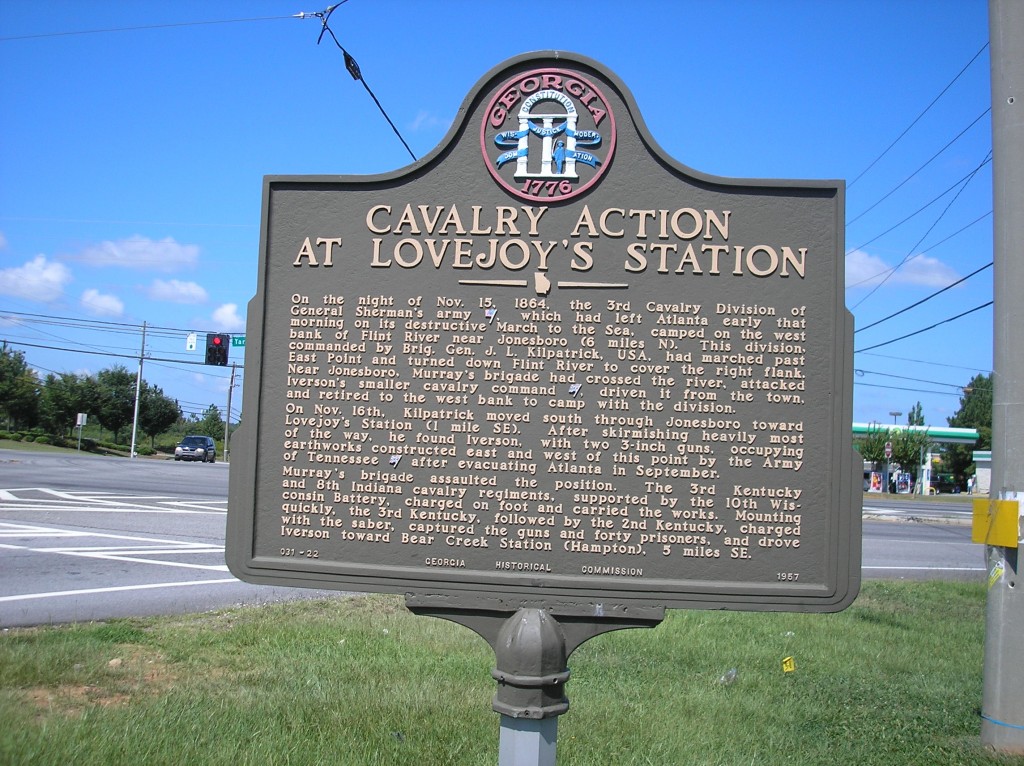
Previously on this blog, the cavalry action at Lovejoy Station was described.
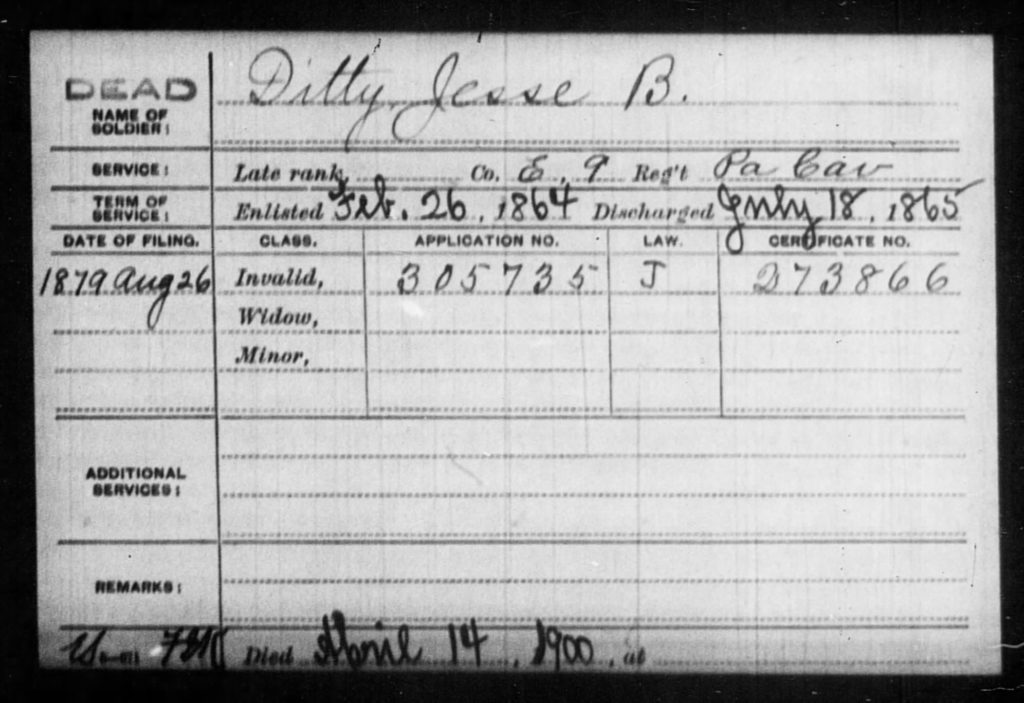
On 26 August 1879, Jesse B. Ditty applied for pension benefits as shown by the card above from Fold3. He was awarded a pension and collected it through to his death, which according to the card, occurred on 14 April 1900.
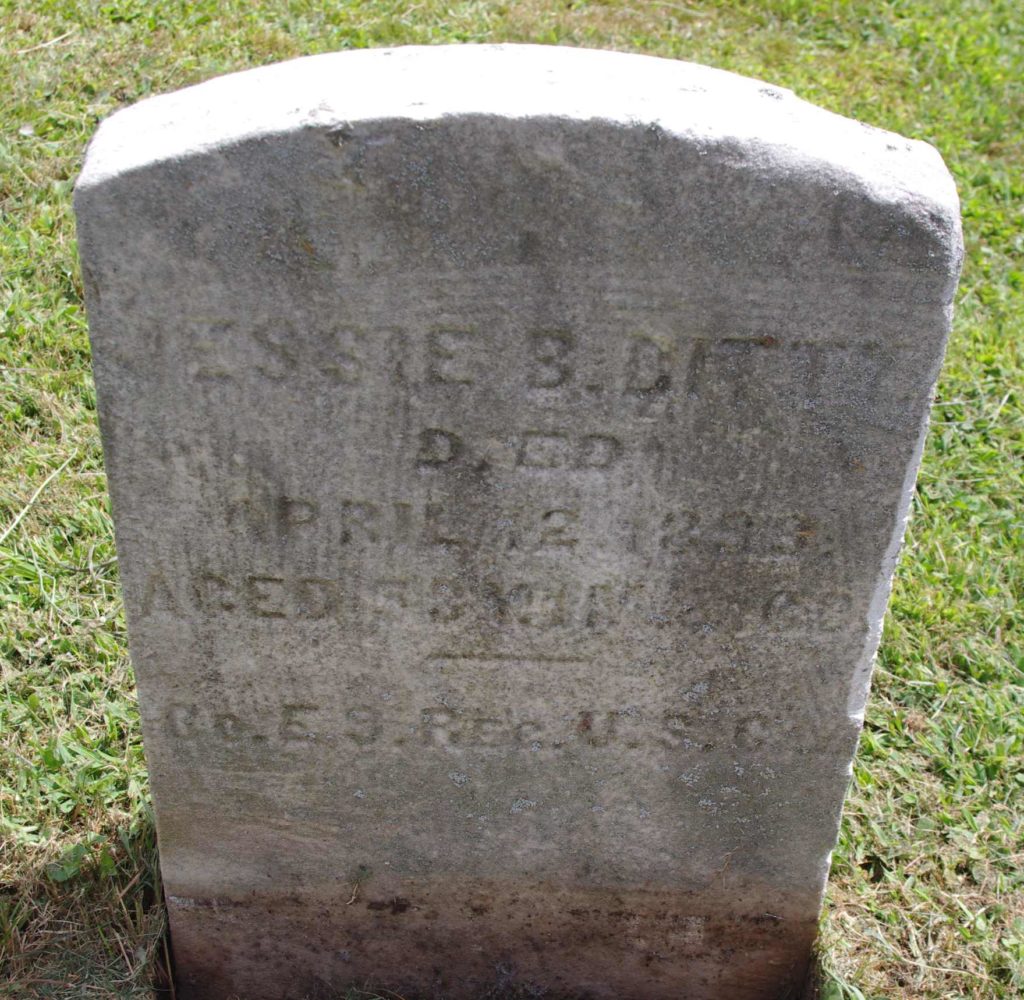
Jesse B. Ditty is buried at Oak Hill Cemetery, Millersburg, Dauphin County, Pennsylvania. His grave marker, shown above, indicates that he died on 12 April 1900 and names his Civil War service.
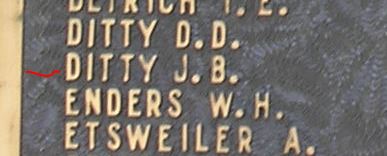
For his war service, he is named on the Millersburg Soldier Monument.
 ;
;


Comments